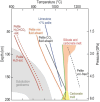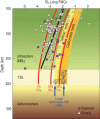The effects of local variations in conditions on carbon storage and release in the continental mantle
- PMID: 38933600
- PMCID: PMC11203914
- DOI: 10.1093/nsr/nwae098
The effects of local variations in conditions on carbon storage and release in the continental mantle
Abstract
Recent advances indicate that the amount of carbon released by gradual degassing from the mantle needs to be revised upwards, whereas the carbon supplied by plumes may have been overestimated in the past. Variations in rock types and oxidation state may be very local and exert strong influences on carbon storage and release mechanisms. Deep subduction may be prevented by diapirism in thick sedimentary packages, whereas carbonates in thinner sequences may be subducted. Carbonates stored in the mantle transition zone will melt when they heat up, recognized by coupled stable isotope systems (e.g. Mg, Zn, Ca). There is no single 'mantle oxygen fugacity', particularly in the thermal boundary layer (TBL) and lowermost lithosphere, where very local mixtures of rock types coexist. Carbonate-rich melts from either subduction or melting of the uppermost asthenosphere trap carbon by redox freezing or as carbonate-rich dykes in this zone. Deeply derived, reduced melts may form further diamond reservoirs, recognized as polycrystalline diamonds associated with websteritic silicate minerals. Carbon is released by either edge-driven convection, which tears sections of the TBL and lower lithosphere down so that they melt by a mixture of heating and oxidation, or by lateral advection of solids beneath rifts. Both mechanisms operate at steps in lithosphere thickness and result in carbonate-rich melts, explaining the spatial association of craton edges and carbonate-rich magmatism. High-pressure experiments on individual rock types, and increasingly on reactions between rocks and melts, are fine-tuning our understanding of processes and turning up unexpected results that are not seen in studies of single rocks. Future research should concentrate on elucidating local variations and integrating these with the interpretation of geophysical signals. Global concepts such as average sediment compositions and a uniform mantle oxidation state are not appropriate for small-scale processes; an increased focus on local variations will help to refine carbon budget models.
Keywords: carbonate melts; continental rifts; craton destruction; deep carbon cycle; lithospheric mantle.
© The Author(s) 2024. Published by Oxford University Press on behalf of China Science Publishing & Media Ltd.
Figures








References
-
- Hirschmann MM, Dasgupta R. The H/C ratios of Earth's near-surface and deep reservoirs, and consequences for deep Earth volatile cycles. Chem Geol 2009; 262: 4–16.10.1016/j.chemgeo.2009.02.008 - DOI
-
- Dasgupta R. Ingassing, storage, and outgassing of terrestrial carbon through geologic time. Rev Mineral Geochem 2013; 75: 183–229.10.2138/rmg.2013.75.7 - DOI
-
- Foley SF, Fischer TP. An essential role for continental rifts and lithosphere in the deep carbon cycle. Nat Geosci 2017; 10: 897–902.10.1038/s41561-017-0002-7 - DOI
Publication types
LinkOut - more resources
Full Text Sources
Miscellaneous
